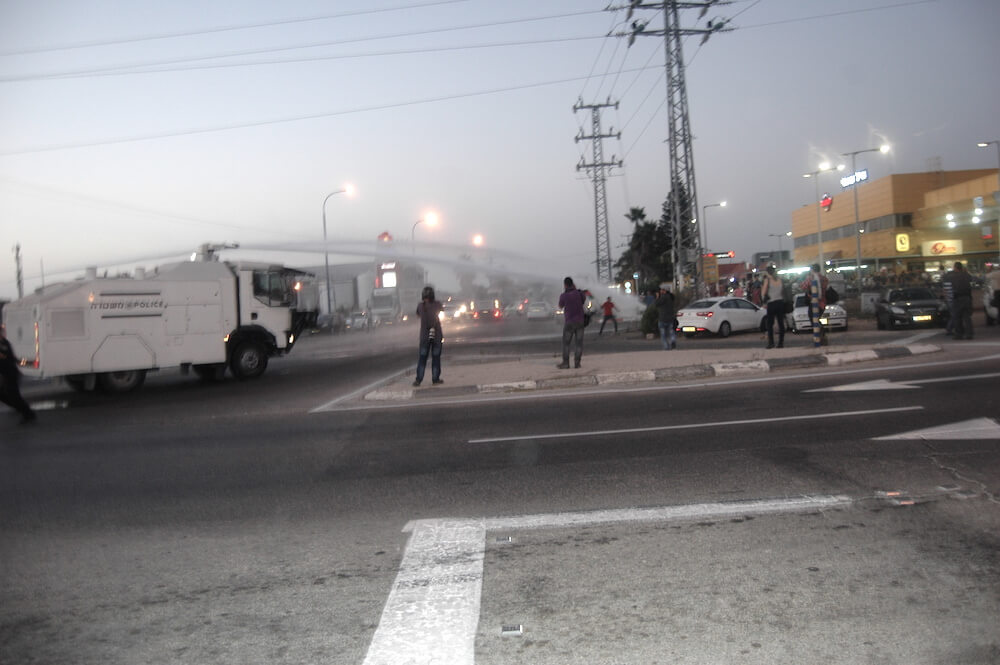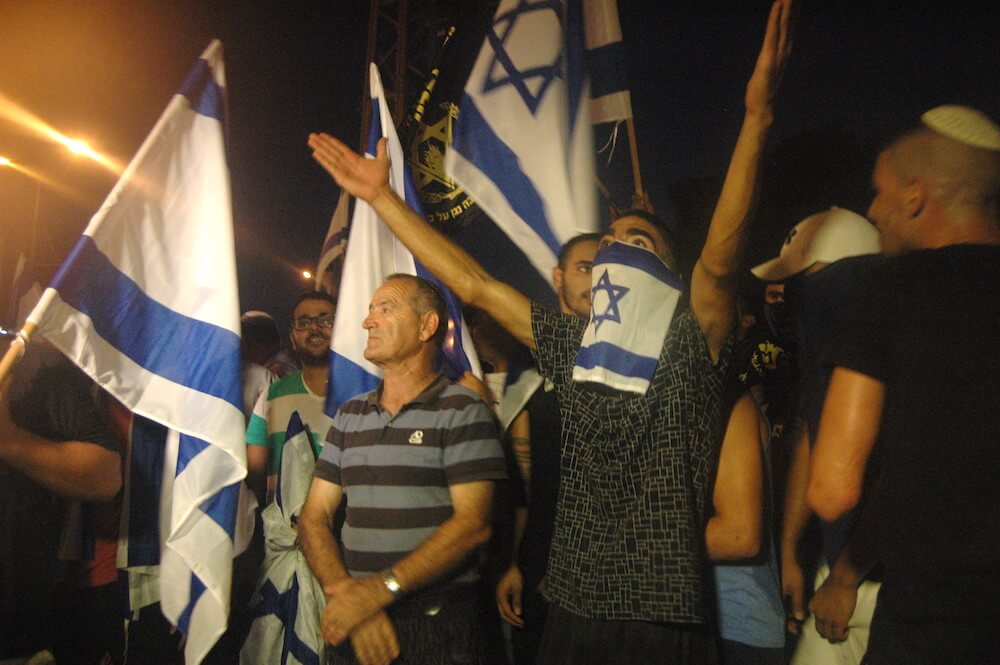Bedlam stretched across the working-class Israeli town of Ashkelon yesterday after Israel reneged on what would have been a first medical visit by a Palestinian health official to Mohammed Allan, 31, a Palestinian hunger striking detainee hospitalized in the coastal Israeli city. For the second time in five days police dispersed Palestinian protesters in Ashkelon using force, and spraying heaps of putrid smelling liquid from a water cannon. This time, soaking demonstrators, members of Knesset and Israeli bystanders alike.
Police arrested 15 Palestinians, thrashing many, including Basel Ghattas, who is a member of the Israeli Knesset. “We are disappointed in the police, but it is not the first time,” Ghattas said, referencing another member of his Joint Arab List party, Jamal Zahalka who suffered a broken bone during a protest in Israel’s Negev desert last year.
One demonstrator was driven out of Ashkelon by an ambulance.



By nightfall word of the violent confrontation had spread, and right-wing residents amassed at the clash point, walking along the main drag, which was closed to passing cars. With a strong anti-police current in the crowd, the Israeli nationalists threw stones at the authorities and chanted “Mohammed is a Pig” “Death to Arabs,” “Death to reporters” and “the Jewish nation lives.”
Police did not use force, or the “skunk water” cannon against the Israeli dissidents.
Earlier in the day Hani Abdeen, the former Palestinian Minister of Health, was scheduled to examine Allan, who went into a coma after his 60th day of fast last Friday. Israel’s prison service had approved Abdeen’s permit last week, yet when he arrived at Barzilai hospital along with a delegation of Arab members of the Israeli Knesset, a phone call from Israel’s Ministry of Security informed him the visit was cancelled.
“He sat with doctors for two hours, and then waited another two hours,” said Hanin Zoabi, a member of the Knesset with the Joint Arab List who along with Ghattas accompanied Abdeen.
“At the end we understood there was a direct order from Netanyahu to not enter and check Mohammed Allan,” Zoabi said. She gained permission to Allan’s treatment room last Monday after applying for a special permit for Knesset members. The Palestinian doctor and Arab members of Knesset say they want to independently monitor Allan’s care, because they are concerned that his present intravenous hydration therapy could contain supplements and vitamins that would violate the terms of his hunger strike.
With the medical review redlined, the Knesset officials were then met by busloads of Palestinians who traveled to Ashkelon from across Israel for a protest outside of the hospital that had been organized days before. Yet Israeli police cordoned off a road leading to the facility and the demonstration was seemingly also cancelled. With that, the Palestinians—Zoabi and Ghattas included—regrouped at a main intersection marking the entrance to Ashkelon in an area where police had sealed off their rented vehicles.
Protesters then hoisted Palestinian flags and moved toward the high-traffic cross-streets. Police dashed towards one youth, knocking him to the ground. Another officer pepper sprayed protesters, sending the Palestinians running in all directions. Israeli authorities pursued them, with arrests taking place across the grassy plots and gas stations at the entrance of the town. Then the skunk water cannon doused the group and border police, covering a chaotic scene in a clear substance with the stench of fecal matter.
Then right-wing residents of Ashkelon staged their own protest against the presence of Arabs inside the Israeli town. Nationalist activists covered themselves with Israeli flags and that of Lehava, an anti-miscegenation group associated with far-right movements. An Israeli photographer working for a wire agency said he was surrounded by the rightists who aggressively demanded to know if he was Jewish.

The photographer remarked that a similar protest and counter protest last Wednesday was even more turbulent. He credited the havoc to Ashkelon’s insular environment. Before 1950 Ashkelon was called Majdal Asqalan and was a Palestinian-Arab agricultural village by the sea. Following an order issued by Israeli’s first Prime Minister David Ben-Gurion and the chief architect of the Israeli army Yigal Allon, Arab villagers were expelled to Gaza and Lod in the backs of trucks. When new Israeli immigrants moved into the town it was renamed Ashkelon. As a result, few Arabs live in there today.
Last week Allan’s hunger strike caused a debate in the Israeli government over a controversial law to permit force-feeding. Israeli medical groups and the Soroka Hospital in Beersheva where Allan was then being held announced they would refuse to implement such an order, even if it was legal. Allan was then moved to Barzilai hospital in Ashkelon where the director said he would go through with the force-feeding if asked.
Allan, a lawyer from a Nablus-area hamlet, was detained last November. He is being held in administrative detention, arrest without trial. His hunger strike was intended to pressure the Israeli government to either release him or bring his case in front of a judge.
In the 1980s three hunger-striking prisoners died when they were asphyxiated by force-feedings, said Qadura Fares, head of the Prisoners Club. “But only one died from hunger.”
Fares said that for decades Palestinians in Israeli jails have employed hunger strikes in order to force the Israeli prison service to enter negotiations with inmates. The first hunger strike took place in 1970. It yielded quality of life upgrades, prompting Palestinians detainees to continue the health-compromising practice. “Beds, radio, tv, pajamas, books– everything was achieved by hunger strikes, not by dialogue,” Fares said.
“Sometimes we have a big achievement, sometimes we don’t succeed. But the majority of these hunger strikes worked, and I don’t remember any development in the improvement of prisoners’ life without a hunger strike,” Fares concluded.
In recent years Palestinian detainees have opted for individual over collective hunger strikes, and in all those cases the jailed were protesting administrative detention orders. “There were many other hunger strikers, that last one was Khader Adnan,” a spokesperson for Islamic Jihad in the West Bank who was let out of prison a month ago, Ghattas said. “They negotiated with him and he was released.”
The former Palestinian detainee has also staged nightly protests in the West Bank along with nearly 100 supporters of Mohammed Allan. On Saturday, Adnan and the Ramallah demonstrators faced off with Palestinian Preventative Security forces as the group attempted to approach the Muqataa, the headquarters for the Palestinian Authority. Last week protesters also shut down offices for the International Committee of the Red Cross (ICRC) in both Ramallah and Jerusalem. The ICRC provides family services for detained Palestinians in Israeli jails and has caught ire in recent years from Palestinians who claim the organization provides cover for Israel’s practice of imprisoning Palestinians without trial.
“Now the decision is in the political level and not in the professional level, and the political level is making if very hard because they want to make it a case study, ensuring all of the potential Palestinian hunger strikers don’t try it,” Ghattas said. Yet for the moment, it is impossible for Israel to come to an accord with Allan as he is unconscious, on a ventilator and being treated with fluids in accordance with a pre-existing Israeli law on protocols for unresponsive patients.
“The paradox here is, if they succeed in curing him or reviewing his health then he will strike again and refuse to take any liquids or any more vitamins or any more supporting materials, and this means he will go [hunger strike] again to the level where he will almost be dying,” Ghattas said.



“Skunk water for Palestinian protesters, not right-wing Jews, in roads near Mohammad Allan’s hunger strike”
Aha! I guessed this would be the case. I posted this earlier today, Allison:
“wrt “Clashes outside hospital of hunger-striking Palestinian”
I was following this on Allison Deger’s twitter. It sounded hellish, as usual. Ghattas was hit by Israel police thugs and sprayed with skunk water as was Zoabi and Allison and everybody else (except Lehava members and Baruch Marzel, I’m sure)”
– See more at: https://mondoweiss.mystagingwebsite.com/2015/08/israel-monitor-protests#sthash.hKqF2kdX.dpuf
Truly deplorable behavior all around by the combined forces of Israel ~ again. Perhaps the “Israeli bystanders” who got soaked with the putrid stuff will complain…
Thanks for your coverage on twitter yesterday and for this full and excellent report, Allison. I hope that you and everyone else affected stay safe.
As for Mr. Alaan~ I hope for his immediate release from ‘administrative detention’ and return to his family and health.
RE: “Skunk water for Palestinian protesters, not right-wing Jews, in roads near Mohammad Allan’s hunger strike”
MY MILLION-DOLLAR IDEA: Designer skunk water for the U.S. – This will allow each municipality/jurisdiction to have its own unique skunk water fragrance. Of course, they will all claim their unique skunk water is the crème de la crème of skunk waters.
Investors welcome!
RE: “Fares said that for decades Palestinians in Israeli jails have employed hunger strikes in order to force the Israeli prison service to enter negotiations with inmates. The first hunger strike took place in 1970. It yielded quality of life upgrades, prompting Palestinians detainees to continue the health-compromising practice.” ~ Deger
A RELEVANT FILM: “Hunger”, 2008, NR, 96 minutes
Acclaimed visual artist Steve McQueen [12 Years a Slave (2013)] makes his feature film debut with this gripping drama (and Independent Spirit Award Best Foreign Film contender) that depicts the events surrounding a hunger strike staged by a group of IRA prisoners during their 1981 incarceration in Britain’s Prison Maze. Led by IRA volunteer-poet Bobby Sands (Michael Fassbender [who is phenomenal in this film]), the strikers waged their six-week-long protest in an attempt to be acknowledged as political prisoners and to improve the prison’s conditions.
Netflix Availability: DVD and Blu-ray
• Netflix Listing – http://dvd.netflix.com/Movie/Hunger/70108808
• IMDb listing – http://www.imdb.com/title/tt0986233/
http://www.youtube.com/watch?v=K9IiUbBV4zc
Force feeding is inhumane and counter productive.Ask the British how that worked out in Northern Ireland.
“British policy at this time was to force feed hunger strikers.[11] According to the National Hunger Strike Commemoration Committee, “six to eight guards would restrain the prisoner and drag him or her by the hair to the top of the bed, where they would stretch the prisoner’s neck over the metal rail, force a block between his or her teeth and then pass a feeding tube, which extended down the throat, through a hole in the block.”[7]
After visiting Michael in jail, his brother John described his condition: “His throat had been badly cut by force feeding and his teeth loosened. His eyes were sunken, his cheeks hollow and his mouth was gaping open. He weighed about six stone.”[5]
During his hunger strike, his weight dropped from 160 lb to 84 lb[2] Gaughan was force-fed from 22 April and this occurred 17 times during course of his hunger strike. The last time he was force-fed was the night before his death on Sunday 2 June. After a hunger strike that lasted 64 days, he died on Monday 3 June 1974, aged 24 years old.[5][6]
The cause of his death was disputed. The British government stated that he died of pneumonia; the Gaughan family stated that he died after prison doctors injured him fatally when food lodged in a lung punctured by a force-feeding tube.[2][12][13]
Gaughan’s death caused controversy in English medical circles, as some forms of treatment can be classed as assault if given without the express permission of the patient.[6]
The timing of his death came just one week after the British Government had capitulated to the demands of Ulster loyalist hunger strikers.[6] After Gaughan’s death, the British government’s policy of force-feeding ended, and the remaining hunger strikers were given assurances that they would be repatriated to Irish prisons. However, these promises were reneged on by the British government.[12][14][15]
Final message
Michael Gaughan left a final message:[5]
I die proudly for my country and in the hope that my death will be sufficient to obtain the demands of my comrades. Let there be no bitterness on my behalf, but a determination to achieve the new Ireland for which I gladly die. My loyalty and confidence is to the IRA and let those of you who are left carry on the work and finish the fight.”
https://en.wikipedia.org/wiki/Michael_Gaughan_(Irish_republican
” In public Margaret Thatcher insisted she would not bend to the demands of republican prisoners in Northern Ireland for “special status”.
However files released by the National Archives under the 30-year rule show the Secret Intelligence Service sent messages to the Provisional IRA leadership in the Maze through an intermediary, promising concessions if the hunger strikes were called off.
The go-between is identified in the files only by the codename “Soon” but he has previously been named as Brendan Duddy, a Londonderry businessman whose contact was MI6 officer Michael Oatley.
Four hunger strikers had already died, including their leader, Bobby Sands, when the remaining hunger strikers issued a statement dropping their demand to be treated as “prisoners of war”.
It gave the British government an opportunity to act and the files relay Soon’s conversations with his handler: “Immediately following the ending of the hunger strike, concessions would be required on clothes, parcels and visits. This, he said, would provide the Provisionals with a face saving way out.”
http://www.telegraph.co.uk/news/politics/margaret-thatcher/8978391/1981-files-Margaret-Thatchers-secret-bid-to-end-IRA-hunger-strikes.html
It just does not work.People support those who are willing to use the most non violent method of resistance by making the ultimate sacrifice in their struggle against oppression.Israel will learn this lesson to their cost.
Bradley Burston in today’s Haaretz throws in the towel and labels Israel apartheid. Numerous examples highlighted it might be behind paywall here’s link and highlights
http://www.haaretz.com/blogs/a-special-place-in-hell/.premium-1.671538
What I’m about to write will not come easily for me.
I used to be one of those people who took issue with the label of apartheid as applied to Israel. I was one of those people who could be counted on to argue that, while the country’s settlement and occupation policies were anti-democratic and brutal and slow-dose suicidal, the word apartheid did not apply.
I’m not one of those people any more. Not after the last few weeks.
Not after terrorists firebombed a West Bank Palestinian home, annihilating a family, murdering an 18-month-old boy and his father, burning his mother over 90 percent of her body – only to have Israel’s government rule the family ineligible for the financial support and compensation automatically granted Israeli victims of terrorism, settlers included.
I can’t pretend anymore. Not after Israel’s Justice Minister Ayelet Shaked, explicitly declaring stone-throwing to be terrorism, drove the passage of a bill holding stone-throwers liable to up to 20 years in prison.
The law did not specify that it targeted only Palestinian stone-throwers. It didn’t have to.
Just one week later, pro-settlement Jews hurled rocks, furniture, and bottles of urine at Israeli soldiers and police at a West Bank settlement, and in response, Benjamin Netanyahu immediately rewarded the Jewish stone-throwers with a pledge to build hundreds of new settlement homes.
This is what has become of the rule of law. Two sets of books. One for Us, and one to throw at Them. Apartheid.